

As you can probably tell from this page, over the years, I've owned
quite a number of cars over the years. I'm a terribly sentimental
creature, and tend to become very attached to all of them - however,
few I have truly enjoyed owning, driving and maintaining as much as
this one.
In the 1980s, this was what Austin hoped to replace the then ageing
Mini with. While it never achieved quite the same phenomenal
level of success, it did prove to be a very popular car, and remained
in various forms a very common sight on the roads for quite a long
period of time. It's only in the last couple of years that the
last incarnation of the Metro, the Rover 100, has really started to
become a rare sight on the UK roads. I was never much of a fan of
the Rover 100 to be honest after having driven the car you see
here. Compared to what I considered to be a "real" Metro, it just
felt, for want of a better word, "soft." While the K-Series
engine gave it a good deal more horsepower, it somehow never felt as
quick, the handling never felt as sharp, and it just felt much more
like any other small car. This thing however is very basic
motoring...You get an engine, four wheels, a steering wheel, a
heater...and that's about it.
One thing which still astonishes me about this car was the incredible
fuel economy it managed to return; even bearing in mind that I seldom
drove it at the optimum 56mph, tended to have a fair bit of fun with it
on a B-Road, and remember it doesn't have a 5th gear - I REGULARLY
averaged between 55 and 60mpg in this car, and the Metro before
it. The Peugeot 107 I own now, built a full 28 years later
struggles to match those figures even when I'm consciously trying to be
economical - and while I've heard from a few people with "eco-cars"
which claim figures like 70mpg, the 40-50mpg mark seems often to be
what actually comes out of the woodwork when they actually start
running real-life calculations (irrespective of what their trip
computers may claim!!!). I'd really be curious to know what I'd
have got out of my Metros if I'd actually tried to deliberately drive
them economically.
It's not all that surprising really though, when you take into account
that this was one of the first cars of its type where serious thought
(and some serious computing power for the time) went into making sure
that every drop of fuel was used to the greatest potential.
Previously, things like proper aerodynamic design had really been
reserved for sports cars and aircraft, but a lot of thought along those
lines, and where possible reducing weight and such measures were
done. It paid off, obviously.
Power was provided by a slightly refined version of the A-Series engine
which had given such faithful service in the Mini for many a year
before-hand. Imaginatively, they named this the A+ Series of
engines. Not a massive change to be honest...but for good reason
I say, because the A-Series was already a fantastic little power plant
to start with. The basic versions of the Metro had a
low-compression engine producing 44bhp, the HLE and HLS models had a
higher compression unit producing a few bhp more. I've never had
a chance to do a direct comparison of these two power units, as the
example in my first Metro had well over 100K on the clock, and was a
very tired and neglected example...so I don't think it would be fair to
compare to it...The fact that it was running at all is a huge testament
to the durability of the power plant I think!
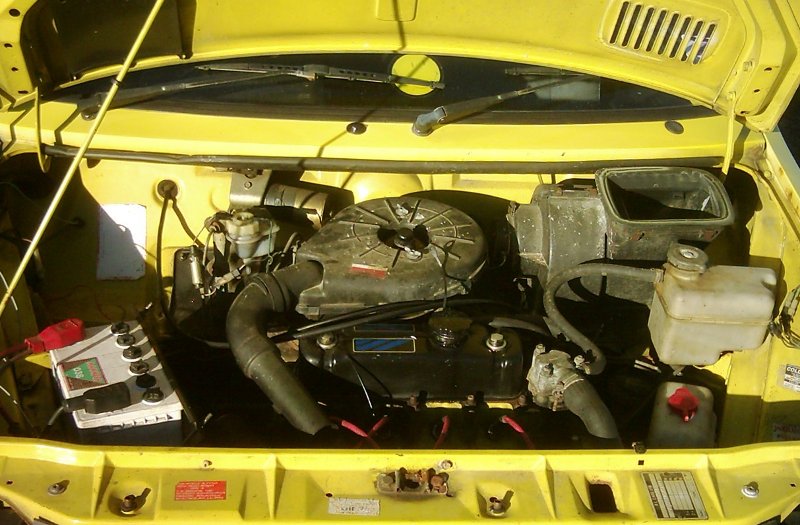
While 40-50bhp doesn't sound like a great deal these days, when you
compare it to other small cars around in the closing years of the 1970s
and the early part of the 1980s, it actually stacked up very
well. It was only really towards the mid 80s when the likes of
the Vauxhall Nova started to appear with very modern engine designs
with substantially higher power ratings, when the stock power output of
the A+ engine started to look a little on the weak side. Even so
- the Metro was still a small and light car, so for day-to-day use, it
really didn't NEED any more power, even in completely standard trim,
the little A+ would quite happily scoot you around at the legal speed
limit, both on and off the motorway. This of course doesn't
negate the fact that it's a very, very tuneable engine. Its
similarity to the A-Series from the Mini, and its massive popularity in
the kit-car circles (due to its compact dimensions and the fact that
the engine and gearbox are one unit - the gearbox lives in the sump)
means that there is a truly massive array of performance upgrades
available for it. Not something I've ever played around with to
any extent whatsoever...aside from regular maintenance, the engine bay
you see above was left alone for the most part.
While it was initially not very fond of rain (a new set of HT leads
soon sorted that), I found it to be a very reliable engine, with no
mechanical problems in the two years I ran this car. I only ever
had one breakdown, caused by a knackered condenser on the
distributor...took all of about ten minutes to replace. Servicing
was so simple that it was laughable, just watch your knuckles on the
radiator when getting the distributor cap off - the fins are
sharp! Think about the only awkward thing to get to in the engine
bay that you might ever really need to get to would be the exhaust
should you ever need to replace the down pipe yourself...it's buried
nicely down the back of the engine, with the braking system in the way
one one side (more so on later cars which had a brake servo, unlike the
one picture above which had fully manual brakes), and the heater on the
other.
Inside, while it looks very basic by today's standards (the horrendous
photograph aside...was a good five or six years ago I sold the car...so
I can't really go and snap another one!), everything you really need is
there. You've seats, instrumentation which tells you all you need
to (including a temperature gauge...something which seems to be
disappearing on more and more cars these days...WHY? I hate not
having anything but a warning light for that...and a brake pad warning
indicator, a sensible inclusion I think and a warning light for the
front seatbelts...something not commonly seen on cars over here during
that period with the exception of Volvos. Unlike the Volvos ones,
at least the one in the Metro didn't tick annoyingly at you whenever
you had the ignition turned on!). The only real glaring omissions
compared to a modern car are headrests and seatbelts in the back
(though these did of course appear in later models...they weren't
needed on this one from 1981 though!), and of course less visibly,
airbags. The drivers seat in my car had been replaced at some
point by one from a later car - quite why this was I never found
out. Nor did I ever find one to match the trim of the rest of the
car - bugged me from day one that did!
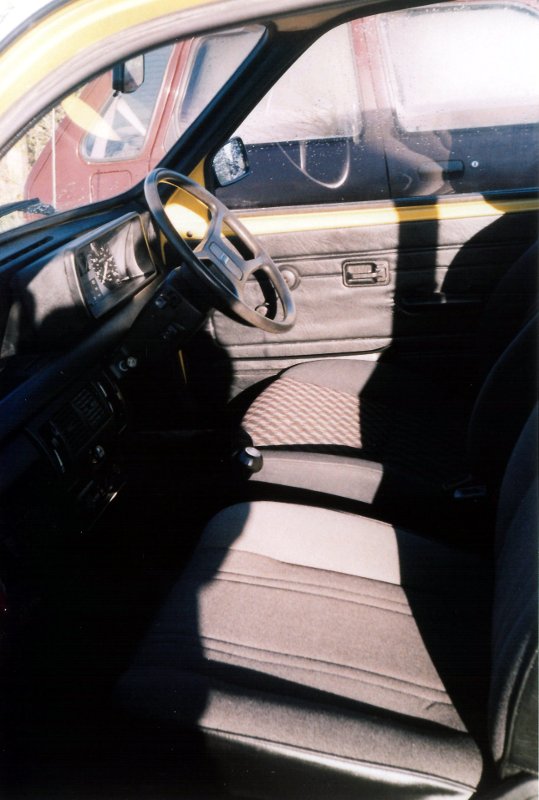
The instrumentation, while basic was a picture of clarity - even if the
fuel gauge in mine only worked reliably on a wet day. I never did
get to the bottom of that! I was used to the cars economy
however, so just used to fill it up every 300 miles or so, which gave
me plenty of a buffer. On the subject of controls and such, the
indicators in the Mk I (Pre 1985 I think) Metros made a really odd
pinging noise due to the thermal flasher unit which was employed - one
of those little random memories from my childhood which I think has
been firmly implanted into my memory for life as one of those silly
little things which I could pick out instantly from anywhere!.
The switches for the accessories are truly unique too, never seen a
design quite like this before in any other car...they actually worked
very well however, even despite the lack of night time illumination
(though the relevant symbols do light up to tell you what's on in the
case of the hazards, rear fog lights and rear screen demister).
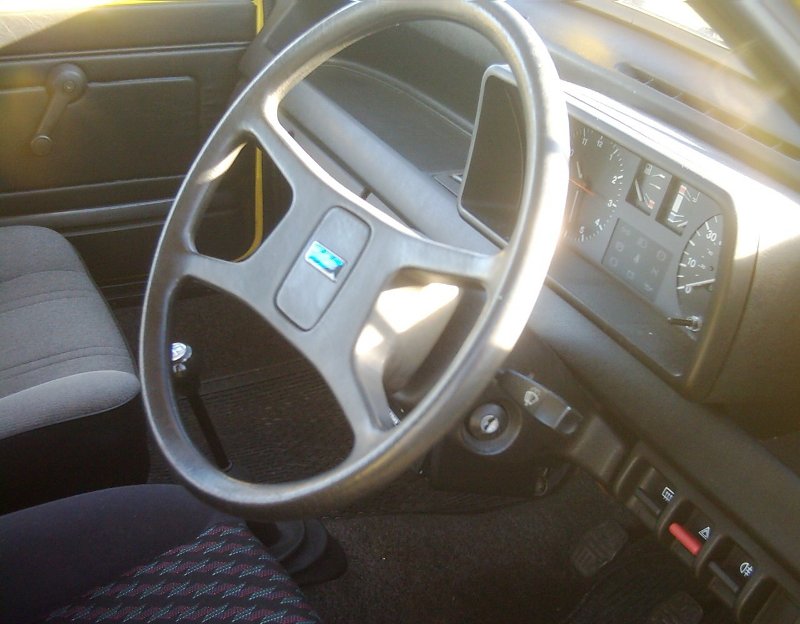
While rear seat space isn't exactly generous, given the diminutive
dimensions of the car as a whole, really isn't bad to be honest.
The split folding rear seats were something not commonly seen on small
cars back then either, and could actually be really handy if you needed
to shift something big and still have seating for three people.
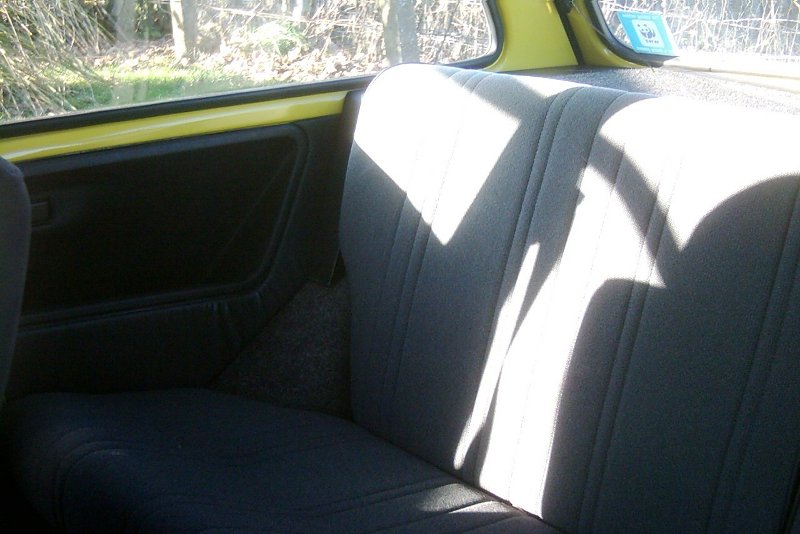
It wasn't a bad looking car, either I think for the time. While
it looks quite dated now, if you go back to the early 80s and compare
it to some others, I think the styling really looks very well
considered. Understated, but smart, and available in a wide
selection of understated, refined, boring, or quite outlandish colours
- like mine, in Snapdragon Yellow. While I had reservations when
someone told me the car was yellow before I'd gone to look at it, the
moment I saw it, I decided it had to be one of the best colours for it
ever.
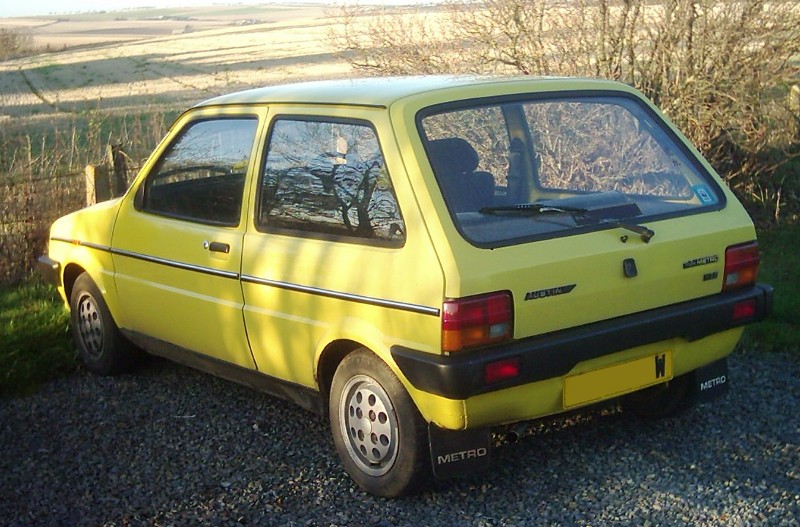
Cosmetically, this car had a few areas where it needed some attention,
but at 21 years old I think that was allowed! The alloys
(actually from an MG Metro) could have done with reconditioning, it
needed a darn good polish throughout (especially the bonnet - though
the camera makes it look worse than it did in person), and I really
needed to get the sills and wiper arms repainted. ...Oh...and the
well and truly knackered rear window sticker, which at some point
probably had a dealers name on it before it yellowed to
near-black. It had gone so brittle however, that getting it off
proved near impossible...so after a few millimetres of fighting with
one corner, I gave up! Oh...and a dent appeared on the offside
rear bumper one day when parked in a supermarket...have to guess that
somebody reversed into my car...never left a note or anything
though. Grrrr....

Of all the cars I've sold through the years, this is the one which I
think I regret selling the most...either that or the Niva...between
them it's a very close thing.
Was just fantastic fun to drive, between the Hydragas suspension which
gave both a very good ride for a small car, and gave astonishingly good
road holding, and the low weight giving a surprisingly good power to
weight ratio, it would never fail to put a smile on your face,
especially on a good twisty road (which we have plenty of here!).
Not to mention the noise the gearbox made in 1st through to 3rd, which
is one of the most distinctive things a lot of people remember from the
Metro. I do have a recording of that somewhere which I'll try to
put up at some point.
It's definitely a classic car now I think - heck, this one, if she's
still around, will be 28 years old now! Not only is it a classic,
I think this is a rare example of a truly practical classic car.
While you'd want to keep the miles off it obviously, if you had or
wanted to, you really could still use one of these cars on a daily
basis. The only proviso for practical reasons would be that you
spent a couple of hundred quid getting the cylinder head converted to
deal with unleaded petrol...you only need to do that once though...and
I imagine that a good percentage of Metros in the hands of enthusiasts
will by now have had that done anyway.
Manufacturer: Austin/British Leyland.
Model: Mini Metro HLE.
Engine: 998cc in-line 4 cylinder petrol, 8 valve, OHV, SU Carburettor.
Gearbox: 4-speed manual.
Power output: 47bhp.
Page last updated: 20th May 2023.